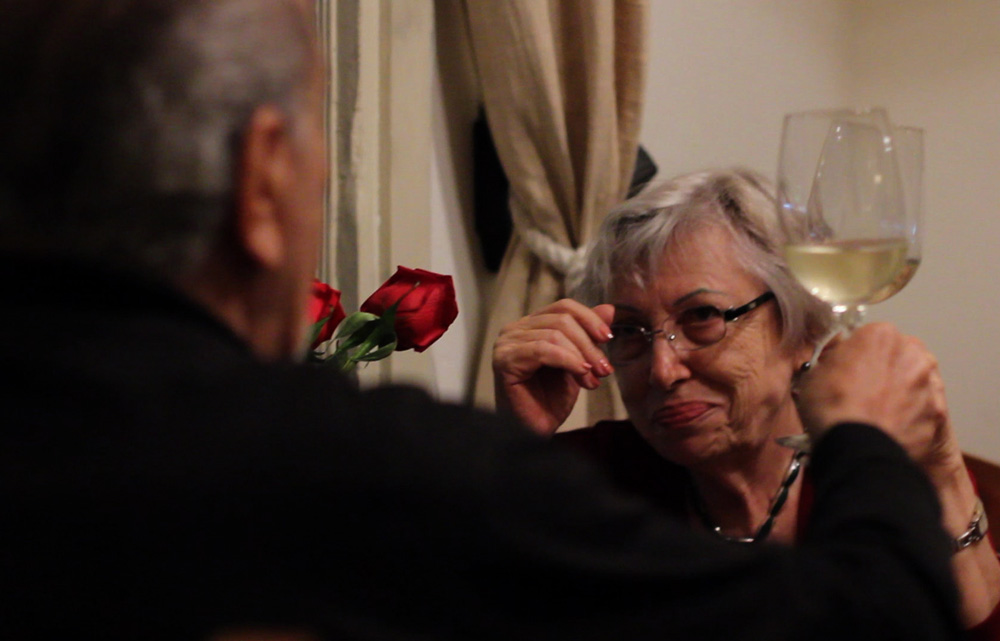Adriana Loeff and Claudia Abend had an idea so good for a documentary that it’s well worth devoting the opening minutes of “La Flor de la Vida” for a peek behind the curtain as Uruguayan septugenarians and octogenarian respond to an ad they saw in the paper, asking if they’d like to tell stories they may have in front of a camera. That may seem like a broad notion, but Loeff and Abend have something specific on their mind as a parade of senior citizens enter an auditorium with their backs towards where an audience would typically sit, just asking these strangers a little bit about themselves to gauge whether they’d be interesting subjects for a film. They find a surefire star in Aldo, and as if they didn’t recognize it themselves, he tells them directly he’ll be a perfect subject, saying “You won’t find many 83-year-olds like me. I’m charming.” The filmmakers follow Aldo home, almost immediately asking about his wife Gabriella, which he partially dismisses by saying, “She is a gem that likes to be hidden, before begrudgingly telling them, “Interview her – you’ll see the difference [between us].”
In fact, those appear to be the exact words Loeff and Abend were hoping Aldo would say as “La Flor de la Vida” becomes a beautiful study of a 48-year marriage based on the premise of opposites attracting. While Alberto is gregarious and clearly loves the attention of a camera (the film has a wealth of archival footage to draw on as a result), Gabriella is a self-described introvert, admitting at one point that part of her initial interest in Aldo was not having to talk so much. But part of the brilliance of “La Flor de la Vida” is learning how Aldo and Gabriella have switched roles over time, not in terms of their personality, but their power dynamics – Gabriella’s reserve has allowed her to enjoy her own company as Aldo needs someone to entertain. (This creates a fascinating subtext, lest you think the filmmakers have taken advantage of Aldo in making this about his marriage as you begin to realize he’s been using them just as much for someone to talk to.)
Loeff and Abend shrewdly weave in other interviews, not from anyone who know Aldo and Gabriella, but of the other strangers they brought into the audition, talking about with more specificity of the own balance they struggled to hit in their own relationships over time and growing older. The broader context gives perspective that Aldo and Gabriella are unlikely to offer up themselves, but striving for universality has some small drawbacks as the filmmakers curiously leave out specifics about Aldo and Gabriella’s life that are alluded to in passing, such as their children and their specific interests, that would seem to make “La Flor de la Vida” more potent as it wears on and leans more on Aldo and Gabriella’s situation to illustrate the ways in which partners can grow apart over time.
Still, this is hardly a dealbreaker as Loeff and Abend’s sensitivity extends beyond how they treat their subjects to facilitate such insight to striking exactly the right bittersweet tone for the film, treating the history between Aldo and Gabriella with the respect it deserves, even when they might not, and letting the candor of the two, as well as all the others who appear in front of the camera, dictate its emotional currents without ever feeling manipulative, funny at times and sad during others, but never dull. Although the question of whether if they’re better together or apart lingers over much of “La Flor De La Vida,” they can definitively chalk up the final film as one of the beautiful things they’ve created as a couple.
“La Flor De La Vida” plays once more at the True/False Film Festival on March 4th at 12:15 pm at the Missouri Theater.




